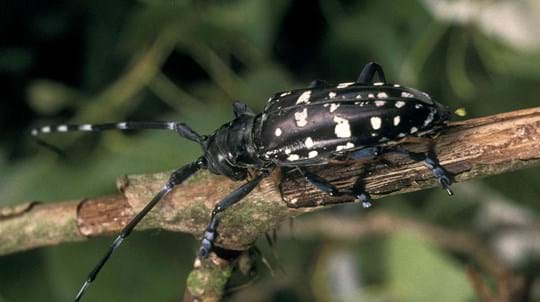
Pests and diseases

Botanic Gardens Conservation International
On a spring day in May 2016, Charles Lane from Fera, his son, my partner and I headed up to the Yorkshire Arboretum near York to hammer nails into trees – all with the permission of the arboretum’s director of course! Nail-in-tree-simulated-ALB-outbreakThese nails (pictured) were to represent bore holes (typically 10mm in diameter) and would become part of a simulated longhorn beetle outbreak site based at the arboretum.
Being able to recognise the signs of a damaging pest is only half the battle. The simulated outbreak site was designed to provide a training ground for volunteers, tree health professionals and the public. As well as offering an opportunity to practise surveying trees for inconspicuous signs, it also aims to emphasize the difficult nature of such surveys which, as participants discovered, is a challenge even when you know exactly what you are looking for.
This simulation was modelled on a similar exercise carried out in North America. This aimed to determine the effectiveness of surveying (Turgeon, Jean J., et al. “Density and location of simulated signs of injury affect efficacy of ground surveys for Asian longhorned beetle.” The Canadian Entomologist 142.1 (2010): 80-96.). In our case the simulation was set up as if it were an outbreak of the Citrus longhorn beetle, Anoplophora chinensis, which is currently absent from the UK, but a pest of great concern. As well as actually finding the ‘holes’ participants also had to correctly identify and make a note of the host species; an important part of any survey.
The chosen outbreak site was the tercentennial wood at the Yorkshire Arboretum, near York. It is a richly populated area with a range of taxa including oaks (Quercus), birch (Betula), beech (Fagus), ash (Fraxinus), hornbeam (Carpinus), maple and sycamore (Acer) and limes (Tilia) among others. This species mix, and how densely populated it is, were the main reasons the site was chosen. It also meant we were able to leave the holes in the trees, as very few people walk through this particular part of the arboretum.
So far, the simulated outbreak site has been tried and tested by two different groups. The first was around 80 first year university students from the Gatsby Plant Science Summer School. The second were a small, but dedicated, group of Observatree volunteers.
The students found almost all of the holes which is unsurprising considering how many of them there were. However the students’ misidentification of trees was high, suggesting observations could be unreliable. Comparatively, although the volunteers did not find all infested trees (mainly due to time constraints), their careful and methodical surveying technique meant that their observations were far more reliable – particularly in terms of host identification.
The outbreak site is an opportunity to raise awareness of and build capacity for surveying damaging pests.
A big thank you to Yorkshire Arboretum for agreeing to host the site and a well done to all those who have taken part so far!